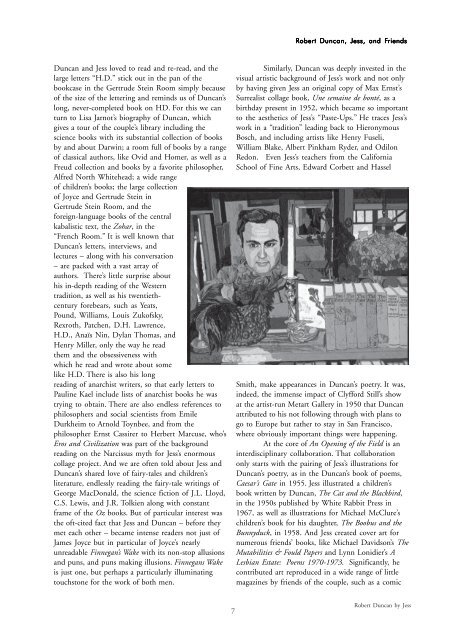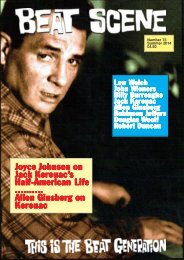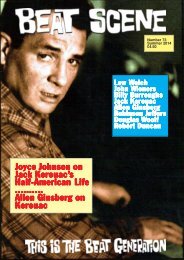Create successful ePaper yourself
Turn your PDF publications into a flip-book with our unique Google optimized e-Paper software.
Robert Duncan, Jess, and Friends<br />
Duncan and Jess loved to read and re-read, and the<br />
large letters “H.D.” stick out in the pan of the<br />
bookcase in the Gertrude Stein Room simply because<br />
of the size of the lettering and reminds us of Duncan’s<br />
long, never-completed book on HD. For this we can<br />
turn to Lisa Jarnot’s biography of Duncan, which<br />
gives a tour of the couple’s library including the<br />
science books with its substantial collection of books<br />
by and about Darwin; a room full of books by a range<br />
of classical authors, like Ovid and Homer, as well as a<br />
Freud collection and books by a favorite philosopher,<br />
Alfred North Whitehead; a wide range<br />
of children’s books; the large collection<br />
of Joyce and Gertrude Stein in<br />
Gertrude Stein Room, and the<br />
foreign-language books of the central<br />
kabalistic text, the Zohar, in the<br />
“French Room.” It is well known that<br />
Duncan’s letters, interviews, and<br />
lectures – along with his conversation<br />
– are packed with a vast array of<br />
authors. There’s little surprise about<br />
his in-depth reading of the Western<br />
tradition, as well as his twentiethcentury<br />
forebears, such as Yeats,<br />
Pound, Williams, Louis Zukofsky,<br />
Rexroth, Patchen, D.H. Lawrence,<br />
H.D., Anaïs Nin, Dylan Thomas, and<br />
Henry Miller, only the way he read<br />
them and the obsessiveness with<br />
which he read and wrote about some<br />
like H.D. There is also his long<br />
reading of anarchist writers, so that early letters to<br />
Pauline Kael include lists of anarchist books he was<br />
trying to obtain. There are also endless references to<br />
philosophers and social scientists from Emile<br />
Durkheim to Arnold Toynbee, and from the<br />
philosopher Ernst Cassirer to Herbert Marcuse, who’s<br />
Eros and Civilization was part of the background<br />
reading on the Narcissus myth for Jess’s enormous<br />
collage project. And we are often told about Jess and<br />
Duncan’s shared love of fairy-tales and children’s<br />
literature, endlessly reading the fairy-tale writings of<br />
George MacDonald, the science fiction of J.L. Lloyd,<br />
C.S. Lewis, and J.R. Tolkien along with constant<br />
frame of the Oz books. But of particular interest was<br />
the oft-cited fact that Jess and Duncan – before they<br />
met each other – became intense readers not just of<br />
James Joyce but in particular of Joyce’s nearly<br />
unreadable Finnegan’s Wake with its non-stop allusions<br />
and puns, and puns making illusions. Finnegans Wake<br />
is just one, but perhaps a particularly illuminating<br />
touchstone for the work of both men.<br />
Similarly, Duncan was deeply invested in the<br />
visual artistic background of Jess’s work and not only<br />
by having given Jess an original copy of Max Ernst’s<br />
Surrealist collage book, Une semaine de bonté, as a<br />
birthday present in 1952, which became so important<br />
to the aesthetics of Jess’s “Paste-Ups.” He traces Jess’s<br />
work in a “tradition” leading back to Hieronymous<br />
Bosch, and including artists like Henry Fuseli,<br />
William Blake, Albert Pinkham Ryder, and Odilon<br />
Redon. Even Jess’s teachers from the California<br />
School of Fine Arts, Edward Corbett and Hassel<br />
Smith, make appearances in Duncan’s poetry. It was,<br />
indeed, the immense impact of Clyfford Still’s show<br />
at the artist-run Metart Gallery in 1950 that Duncan<br />
attributed to his not following through with plans to<br />
go to Europe but rather to stay in San Francisco,<br />
where obviously important things were happening.<br />
At the core of An Opening of the Field is an<br />
interdisciplinary collaboration. That collaboration<br />
only starts with the pairing of Jess’s illustrations for<br />
Duncan’s poetry, as in the Duncan’s book of poems,<br />
Caesar’s Gate in 1955. Jess illustrated a children’s<br />
book written by Duncan, The Cat and the Blackbird,<br />
in the 1950s published by White Rabbit Press in<br />
1967, as well as illustrations for Michael McClure’s<br />
children’s book for his daughter, The Boobus and the<br />
Bunnyduck, in 1958. And Jess created cover art for<br />
numerous friends’ books, like Michael Davidson’s The<br />
Mutabilities & Fould Papers and Lynn Lonidier’s A<br />
Lesbian Estate: Poems 1970-1973. Significantly, he<br />
contributed art reproduced in a wide range of little<br />
magazines by friends of the couple, such as a comic<br />
7<br />
Robert Duncan by Jess





